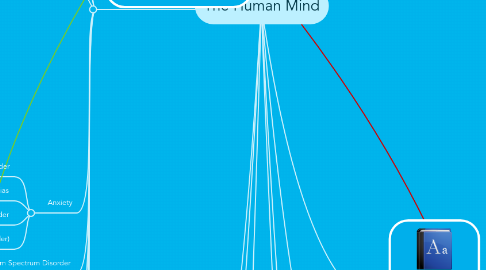
1. Physical
1.1. Axons
1.2. Dendrites
1.3. Neurotransmitters
1.4. Synapses
1.5. Parietal Lobe
1.6. Occipital Lobe
1.7. Frontal Lobe
1.8. Cerebellum
1.9. Hippocampus
1.10. Hypothalmus
1.11. Basal Ganglia
1.12. DLS (Deep Limbic System)
1.13. Amygdala
1.14. Corpus Collosum
1.15. Medulla Oblongata
1.16. RAS
1.17. Anterior Cingulate
1.18. Interior Cingulate
1.19. New node
2. Structural Disorders
2.1. Unipolor
2.2. Bipolar
2.3. Schizophrenia
2.3.1. Types
2.3.1.1. Catatonic
2.3.1.2. Residual
2.3.1.3. Disorganized
2.3.1.4. Paranoid
2.3.1.5. undifferentiated
2.3.2. Symptoms
2.3.2.1. Speech and thought disorders
2.3.2.2. hallucinations and delusions
2.3.2.3. psychomotor disturbance
2.3.2.4. inappropriate emotional responses
2.3.2.5. bizarre behavior
2.3.2.6. reduced intellectual and self help ability
2.4. ADHD
2.4.1. Attention Deficit Disorders
2.4.1.1. Symptoms
2.4.1.1.1. often fidgets or squirms in seats
2.4.1.1.2. has difficulty staying seated
2.4.1.1.3. is easily distracted
2.4.1.1.4. has difficulty waiting turns in a group
2.4.1.1.5. often blurts out answers to questions
2.4.1.1.6. has difficulty following directions
2.4.1.1.7. has difficulty sustaining attention to tasks
2.4.1.1.8. shifts from one uncompleted task to another
2.4.1.1.9. has difficulty playing quietly
2.4.1.1.10. often talks excessively
2.4.1.1.11. often interrupts or intrudes on others
2.4.1.1.12. often does not seem to listen
2.4.1.1.13. often looses things necessary for tasks
2.4.1.1.14. often engages in dangerous activities
2.5. Anxiety
2.5.1. OCD (obsessive Compulsive disorder
2.5.2. Phobias
2.5.3. Panic Disorder
2.5.4. GAD (generalized anxiety Disorder)
2.6. ASD (autism Spectrum Disorder
2.7. Asperger's Syndrome
2.7.1. Symtoms
2.7.2. New node
2.8. Dyslexia
2.9. Epilepsy
2.9.1. Seizures
2.9.2. Grand Mahl
2.9.3. Brain is firing at up to four times normal speeed
2.10. Retardation
3. Learning
3.1. Chunking
3.2. Gathering information in groups
3.3. The Magic Seven
3.3.1. Learning things in groups of seven
3.4. Testing as a learning process
3.5. Schemas
3.5.1. skeletons
3.5.2. outlines
3.5.3. abstract cognitive structures
3.6. Own it!
3.6.1. Rework notes
3.7. Review
3.7.1. always review topics covered
3.8. Breaks
3.8.1. Every1 and a half hours
3.8.2. Gelling time
3.8.3. New neurotransmitters need time set themselves up
3.9. Sleep
3.9.1. Always get a good night sleep
3.9.2. Helps posit things in Long-term memory
3.10. Memory
4. Personality
4.1. Personality Tests
4.2. Reliability
4.3. Variance
4.4. The Big Five
4.4.1. The need for stability
4.4.2. extraversion
4.4.3. originality
4.4.4. accomodation
4.4.5. consolidation
5. Neurotransmitters
5.1. GABA
5.2. Endorphins
5.3. Serotonin
5.4. Glutamate
5.5. Dopamine
6. Philosophy
6.1. Cartesian Dualism
6.1.1. The belief that we have our physical bodies and mind that is intangible
6.1.2. We have feelings, loves and ideas that are all part of the soul
6.1.3. Francis Crick
6.1.3.1. The astonishing hypothesis
6.2. IQ
6.2.1. Intelligences
6.2.1.1. Spatial Reasoning
6.2.1.2. abstract thought
6.2.1.3. understanding
6.2.1.4. communication
6.2.1.5. reasoning
6.2.1.6. Learning
6.3. Giftedness
6.3.1. New node
6.4. Epistemology
6.4.1. What is knowledge
6.4.2. How do we know what we know
7. Drugs
7.1. Alcohol
7.1.1. A disinhibitor
7.1.2. unlocks "normal" inhibitions
7.1.3. Depressant
7.1.4. destroys brain cells in the left hemisphere
7.2. Aspirin
7.2.1. Good for stroke and heart attack
7.2.2. beneficial on dementia patients
7.3. Cocaine
7.3.1. New node
7.4. Caffeine
7.4.1. stimulant
7.4.2. Causes arousal like that of stress
7.4.3. releases cortisol
7.4.4. Prevents the relaxing affects of adenosine
7.4.5. Caffeine intoxication
7.4.6. restlessness
7.4.7. nervousness
7.4.8. insomnia
7.4.9. flushed face
7.4.10. diuresis
7.4.11. gastrointestinal disturbance
7.4.12. muscle twitching
7.4.13. rambling flow of that and speech
7.4.14. cardiac arrhythmia
7.4.15. psychomotor agitation
7.5. Marijuana
7.6. Nicotine
7.6.1. Interrupts the flow of oxygen to the brain
7.7. Brain Nutrient
7.8. Amphetamines
7.8.1. block dopamine and norepenephrine re-uptake channels
7.8.2. New node
7.9. Opiates
7.9.1. Mimic endorphins
7.9.2. Calms the body
7.10. Mescaline
7.10.1. Mimics norepenephrine
7.11. LSD
7.12. New node
8. Sleep
8.1. the average adult sleeps 7 hours a night
8.2. sleep produces HGH or (human Greoth Hormone)
8.3. People get 4-5 sleep cycles a night
8.4. the average cycle lasts from 60to 90ms
8.5. There are five stages to each cycle
8.6. Pre-sleep(beta waves) Normal alertness
8.7. Phase 1: (alpha waves) The mind at rest, eyes closed breathing slowed and images begin to appear
8.8. Phase 2: (theta Waves) Light sleep
8.9. Phase 3: (delta waves) or Deep sleep
8.10. Phase 4: REM (rapid Eye Movement) dreaming
8.11. Phase 5: (Theta waves) light sleep signaling the end of a cycle
9. Problem Solving
9.1. creativity
9.1.1. A product or useful response
9.1.2. a task that is heuristic rather than algorithmic
9.1.3. Novelty
9.1.4. relevance
9.1.5. spontenaeity
9.1.6. originality
9.1.6.1. Conceptual replication
9.1.6.2. redefinition
9.1.6.3. Forward incrementation
9.1.6.4. Advance forward incrementation
9.1.6.5. redirection
9.1.6.6. Reconstruction and redirection
9.1.6.7. Re-initiation
9.2. The creative Personality
9.2.1. Relevant skills
9.2.1.1. Cognitive style
9.2.1.2. knowledge of heuristics
9.2.1.3. work style
9.2.1.4. More relevant skills
9.2.1.4.1. Self-discipline
9.2.1.4.2. Delay of gratification
9.2.1.4.3. perseverance
9.2.1.4.4. Independent judgement
9.2.1.4.5. tolerance for ambiguity
9.2.1.4.6. autonomy
9.2.1.4.7. absence of sex-role stereotyping
9.2.1.4.8. Internal Locus of control
9.2.1.4.9. willingness to take risks
9.2.1.4.10. ability to be a self starter
9.2.1.4.11. absence of conformity to social pressure
